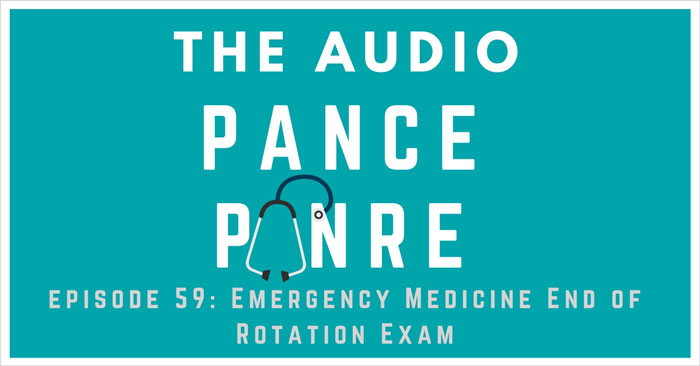Podcast: Play in new window | Download
Subscribe: Apple Podcasts | RSS
The Audio PANCE/PANRE PA Board Review Podcast
Welcome to episode 59 of the FREE Audio PANCE and PANRE Physician Assistant Board Review Podcast.
Join me as I cover ten Emergency Medicine End of Rotation Exam (EOR) review questions from the SMARTYPANCE course content following the NCCPA™ and PAEA content blueprint (download the FREE cheat sheet).
This week we will be covering ten emergency medicine end of rotation exam questions based on the NCCPA PANCE and PANRE Content Blueprint.
Below you will find an interactive exam to complement the podcast.
I hope you enjoy this free audio component to the examination portion of this site. The full board review includes over 2,000 interactive board review questions and is available to all members of the PANCE and PANRE Academy and SMARTYPANCE which are now bundled together into one very low price.
- You can download and listen to past FREE episodes here, on iTunes, on Google Play Music or Stitcher Radio.
- You can listen to the latest episode, take an interactive quiz and download your results below.
- Members can take Emergency medicine EOR 1 (200 questions) and Emergency Medicine EOR 2 (184 questions)
Listen Carefully Then Take The Practice Exam
If you can’t see the audio player click here to listen to the full episode.
Episode 59 – Emergency Medicine EOR Podcast Quiz
The following 10 questions are linked to NCCPA Content Blueprint lessons from the SMARTYPANCE and PANRE Board review website. If you are a member you will be able to log in and view this interactive video content.
1. During a baseball game, a 22-year-old college student is hit in the right eye by a baseball. He complains of blurry vision in that eye. On physical exam, the physician assistant notes proptosis of the right eye and limitation of movement in all directions. On CT scan, which of the following is most likely to be seen?
A. Fracture of the medial orbital wall
B. Prolapse of orbital soft tissue
C. Hematoma of the orbit
D. Orbital emphysema
2. A 29-year-old male presents with a complaint of substernal chest pain for 12 hours. The patient states that the pain radiates to his shoulders and is relieved with sitting forward. The patient admits to recent upper respiratory symptoms. On examination vital signs are BP 126/68, HR 86, RR 20, temp 100.3 degrees F. There is no JVD noted. Heart exam reveals regular rate and rhythm with no S3 or S4. There is a friction rub noted. Lungs are clear to auscultation. EKG shows diffuse ST-segment elevation. What is the treatment of choice for this patient?
A. Pericardiocentesis
B. Nitroglycerin
C. Percutaneous coronary intervention
D. Indomethacin (Indocin)
3. A 19-year-old female presents with a sore throat for nearly two weeks. She complains of fatigue and a low-grade fever. On physical examination, there is cervical, axillary, and inguinal lymphadenopathy, and mild splenomegaly. On review of the blood smear, which of the following would be expected?
A. Atypical lymphocytes
B. Hypersegmented neutrophils
C. Hypochromic red blood cells
D. Schistocytes
4. A 30-year-old female complains of fatigue, weakness, diminished appetite, weight loss, and syncope. She denies fever, chest or abdominal pain, palpitations, changes in bowel patterns or sleep patterns. Physical examination reveals a thin female, BP 90/65 mmHg, and pulse 80 beats per minute. Pulmonary, cardiovascular, abdominal, and neurologic exam are without abnormalities. Areas of brown and bronze hyperpigmentation are noted on her elbows and the creases of her hands. Which of the following tests will be the most useful in making the diagnosis?
A. Drug screen
B. Urine dipstick
C. Complete blood count
D. Serum creatinine kinase
5. A 15-year-old male was seen last week with complaints of a sore throat, headache, and mild cough. A diagnosis of URI was made and supportive treatment was initiated. He returns today with complaints of worsening cough and increasing fatigue. At this time, chest x-ray reveals bilateral hilar infiltrates. A WBC count is normal and a cold hemagglutinin titer is elevated. The most likely diagnosis is
A. tuberculosis.
B. mycoplasma pneumonia.
C. pneumococcal pneumonia.
D. staphylococcal pneumonia.
6. Which of the following clinical manifestations is common in candidal vulvovaginitis?
A. Extreme vulvar irritation
B. Firm, painless ulcer
C. Tender lymphadenopathy
D. Purulent discharge
7. A 63-year-old female presents with a complaint of chest pressure for one hour noticed upon awakening. She admits to associated nausea, vomiting, and shortness of breath. 12 lead EKG reveals ST-segment elevation in leads II, III, and AVF. Which of the following is the most likely diagnosis?
A. Aortic dissection
B. Inferior wall myocardial infarction
C. Acute pericarditis
D. Pulmonary embolus
A. Epstein-Barr virus
B. Group C Streptococcus
C. Coxsackievirus
D. Gonorrhea
9. Which of the following is the most appropriate management of acute psychosis in a patient with schizophrenia?
A. Amitriptyline (Elavil)
B. Risperidone (Risperdal)
C. Lithium (Eskalith)
D. Sertraline (Zoloft)
10. A 25-year-old presents with pain in the proximal ulna after falling directly on the forearm. X-ray shows a fracture of the proximal 1/3rd of the ulna. There is an associated anterior radial head dislocation. What is the proper name for this condition?
A. Galeazzi fracture
B. Monteggia fracture
C. Colles’ fracture
D. Smith fracture
Looking for all the podcast episodes?
This FREE series is limited to every other episode, you can download and enjoy the complete audio series by joining The PANCE and PANRE Exam Academy + SMARTYPANCE
I will be releasing new episodes every few weeks. The Academy is discounted, so sign up now.
Resources and Links From The Show
- My list of recommended PANCE and PANRE review books
- Download the FREE PANCE and PANRE Blueprint Checklist
- Get 20% of any Picmonic membership by using this link
- Sign up for the FREE daily PANCE and PANRE email series
- Join the Smarty PANCE NCCPA Content Blueprint Website + The PA Life Academy
- Members can take Emergency medicine EOR 1 (200 questions) and Emergency Medicine EOR 2 (184 questions)
- USE CODE “PALIFE” TO GET 10% OFF THE RUTGERS PANCE AND PANRE REVIEW COURSE
This Podcast is also available on iTunes and Stitcher Radio for Android
- iTunes: The Audio PANCE AND PANRE Podcast iTunes
- Stitcher Radio: The Audio PANCE and PANRE Podcast Stitcher
Download The Content Blueprint Checklist
Follow this link to download your FREE copy of the Content Blueprint Checklist
Print it up and start crossing out the topics you understand, marking the ones you don’t and making notes of key terms you should remember. The PDF version is interactive and linked directly to the individual lessons on SMARTY PANCE.


